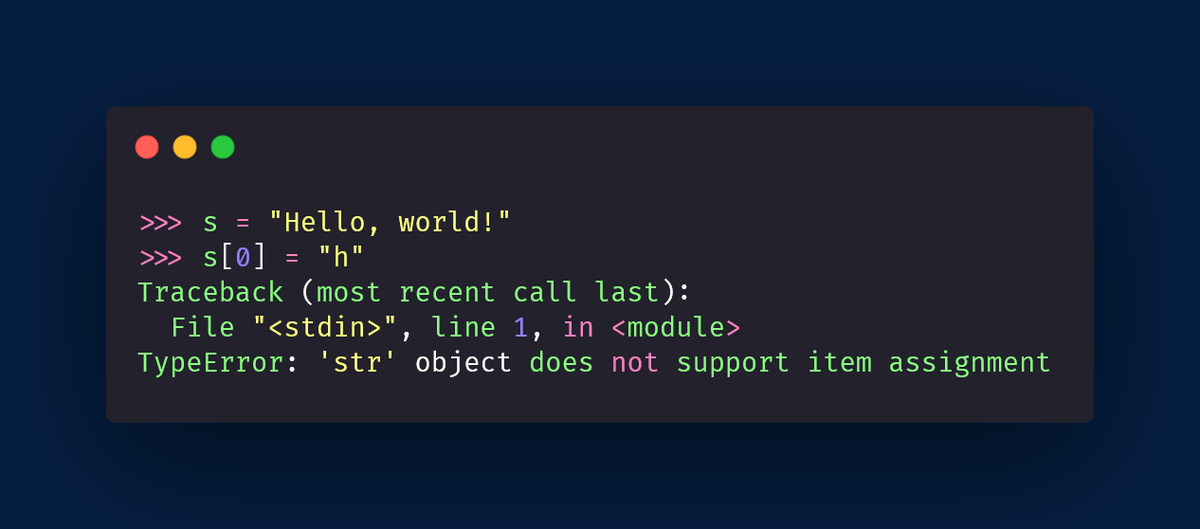
I have been tweeting about Python 🐍 string formatting.
I have been preaching 🙏 that f-strings are the best string formatting alternative.
Then comes the string method `.format`.
And only then, %-formatting.
Here is a thread 🧵 comparing the 3 👇
I have been preaching 🙏 that f-strings are the best string formatting alternative.
Then comes the string method `.format`.
And only then, %-formatting.
Here is a thread 🧵 comparing the 3 👇

In its most basic form,
👉 %-formatting uses % and a letter inside the string
👉 `.format` replaces sequences of {} with the data
👉 f-strings use {} to insert the data _inside_ the string
Here is how it looks like 👇
👉 %-formatting uses % and a letter inside the string
👉 `.format` replaces sequences of {} with the data
👉 f-strings use {} to insert the data _inside_ the string
Here is how it looks like 👇

An undervalued feature of string formatting is that you can easily determine whether your data should be formatted with its string (str) or with its representation (repr).
For debugging, `repr` is usually more useful.
Here is how this looks like 👇
For debugging, `repr` is usually more useful.
Here is how this looks like 👇

Aligning the data inside a field is also much easier with `.format` and f-strings.
For one, %-formatting can't handle centre alignment.
Secondly, with `.format` and f-strings you just use <^>, which points to where the alignment should be!
Easy to remember 🤔💭✅
For one, %-formatting can't handle centre alignment.
Secondly, with `.format` and f-strings you just use <^>, which points to where the alignment should be!
Easy to remember 🤔💭✅

Now, to be fair, there are some situations when I think `.format` is better than f-strings.
Such an example is when we have the formatting data inside a dictionary, with string keys.
In that case, `.format` is great!
Such an example is when we have the formatting data inside a dictionary, with string keys.
In that case, `.format` is great!

There is another situation in which `.format` and f-strings completely blow %-formatting out of the water.
With `.format` and f-strings, we can implement custom formatting specifiers for our own objects.
All we need is `__format__`!
Here is a (silly) demo 👇
With `.format` and f-strings, we can implement custom formatting specifiers for our own objects.
All we need is `__format__`!
Here is a (silly) demo 👇

These were just some comparison points between the three main ways of doing string formatting in Python.
I took these examples from a Pydon'ts article of mine, that you can read here 👇
mathspp.com/blog/pydonts/s…
I took these examples from a Pydon'ts article of mine, that you can read here 👇
mathspp.com/blog/pydonts/s…
I'm currently working on a string formatting case study.
What I mean is, I will take an old Python project that is used in real life...
But that uses only %-formatting.
And I will review the whole thing, upgrading the string formatting as I go.
What I mean is, I will take an old Python project that is used in real life...
But that uses only %-formatting.
And I will review the whole thing, upgrading the string formatting as I go.
Then, I will write a full article explaining
👉 what I did
👉 where I decided to use f-strings and where I decided to use `.format`
👉 why I made those decisions
Sounds interesting?
Then subscribe to my newsletter to stay in the loop 😉
mathspp.com/subscribe
👉 what I did
👉 where I decided to use f-strings and where I decided to use `.format`
👉 why I made those decisions
Sounds interesting?
Then subscribe to my newsletter to stay in the loop 😉
mathspp.com/subscribe
TL;DR:
👉 f-strings are generally better than `.format`:
shorter & more expressive
👉 %-formatting should be avoided:
old & less features
👉 do modern alignment with <^>
👉 .format is nicer than f-strings when data is in a dictionary with string keys
See you around 👋
👉 f-strings are generally better than `.format`:
shorter & more expressive
👉 %-formatting should be avoided:
old & less features
👉 do modern alignment with <^>
👉 .format is nicer than f-strings when data is in a dictionary with string keys
See you around 👋
• • •
Missing some Tweet in this thread? You can try to
force a refresh













